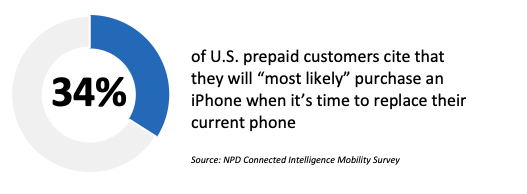
Apple unveils the new iPhone SE
The wait is finally over as Apple last week released its much-speculated budget phone, the iPhone SE. The new phone is essentially a reengineered iPhone 8 with an ultra fast A13 bionic chipset, which powers the current iPhone 11 series flagships, under the hood. The phone features a 4.7-inch LCD display with single cameras at the front and the back, and will retail between $399 and $549, depending on storage capacity, beginning April 24th. Notably, some of the U.S. carriers have immediately begun promoting the new SE with aggressive savings. AT&T, for instance, is offering the new phone for as low as $5/month (on a 30-month EIP) with new line activations on unlimited plans.
The NPD Take:
- Apple’s initial iPhone SE model launched back in 2016 was a huge success as it helped price-sensitive customers and first-time smartphone buyers (mainly kids) join the Apple ecosystem. The new SE’s similarly aggressive pricepoint, especially during the COVID-driven recession environment, should be a big hit among prepaid customers as well as teen/kid users.
- While the $399 starting price is expected to put pressure on Apple’s iPhone ASPs (device revenues), it should be remembered that Apple enjoys substantially high amounts of revenues generated by its services. The new comers at the $399 entry pricepoint will eventually contribute to the Apple service pool as some of them will keep their Apple TV+ subscription after the 1-year of free service, or download paid apps, subscribe to iCloud or Apple Pay.
- The small display on the initial SE, which used the same chassis of the 4.0-inch iPhone 4/5 platform, was not a major restraint as the majority of the phones sold in the market had a screen size of under 5-inches. Come 2020, however, customers demand larger displays as they have become more nomadic with their media consumption habits. Many of the top-selling prepaid smartphones such as Samsung’s Galaxy A10/A20 or LG’s Stylo series boast large displays (6.2-inches or larger), thus a 4.7-inch new budget iPhone may not be as attractive as the initial 4.0-inch iPhone SE back when it was introduced four years ago.
OnePlus officially joins the Verizon lineup with the new OnePlus 8
OnePlus has long been teasing the mobile community with its new flagship device offering, and the OEM has finally taken the wraps off the new flagship, the OnePlus 8 series. The new phone comes in two variants, the top flagship OnePlus 8 Pro and the budget version OnePlus 8. Both phones are 5G-ready (powered by the Qualcomm Snapdragon 865 chipset) but the Pro version quite naturally excels in device featueres with a 120 MHz refresh rate screen (vs. 90 MHz on the regular 8), wireless charging and IP68 rating. However, it is the budget version OnePlus 8 that was able to secure commitment from longtime partner T-Mobile, and a new carrier partner, Verizon Wireless. Both carriers will begin selling the new OnePlus 8 at $699 at the end of the month. The flagship OnePlus 8 Pro, on the other hand, will be sold unlocked through OnePlus’ website as well as a new channel partner, Amazon.com. The superphone will carry a price tag of $899 or $999 depending on the RAM and storage capacity.
The NPD Take:
- Last week when we reported on OnePlus’ upcoming 8 series phones, we commented on the importance of expanding carrier distribution in order to extend the reach of the OnePlus brand in the US market. OnePlus has been only working with T-Mobile and Sprint (which is now a part of T-Mobile), thus winning shelf space at Verizon Wireless will certainly help boost the OEM’s profile in the market.
- T-Mobile and Verizon Wireless’ decisions to pass on the expensive OnePlus 8 Pro makes sense considering the $899-$999 price point comes a bit too close to high-end offerings from Samsung and Apple. The specs on the new OnePlus 8 Pro may almost be on par with Samsung’s latest flagship S20 series, but the OEM still has a long way to go in terms of brand recognition to justify those price points. According a recent NPD survey conducted in early February, only 10% of U.S. smartphone owners have heard of the OnePlus brand.
Metro by T-Mobile offers the iPhone 7 for $29
Days after Apple’s announcement on the debut of the low cost ($399) iPhone SE, Metro by T-Mobile announced an aggressive promotion targeting iPhone customers as well as those Android users that have been bypassing the iPhone option due to cost. Metro is now offering new customers the iPhone 7 for only $29 when activated on its $40/month unlimited plan, that offers video streaming quality at 480p and comes with no throttling or deprioritization (until 35GB/month of data consumption).
The NPD Take:
- Despite being the nation’s prepaid brand in terms of subscribers, Metro by T-Mobile has long been behind the curve in iPhone penetration. This was partially driven by Metro’s latency in merchandising iPhones; the prepaid carrier was not offering an iPhone to its customers up until the summer of 2016. Metro has previously launched aggressive and interesting iPhone-specific promotions (such as the free AirPod offer for iPhone BYOD customers), but they were not as aggressive as the $29 iPhone 7 offers.
- Boosting the subsidies to attract expand the iPhone base is a good strategy considering the negative correlation between iPhone ownership and churn. iPhone owners tend to use their phones for longer periods compared to low-end Android owners, thus their propensity to churn (to look for new deals at rival carriers) is much lower.